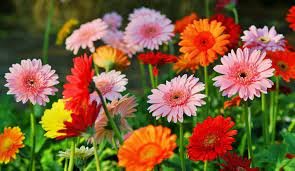**Exploring Popular Varieties and Different Shapes of Marigold Flowers**

Marigold flowers, known for their vibrant colors, cheerful blooms, and versatility, come in a wide array of varieties, each with its unique characteristics and appeal. From compact French marigolds to towering African marigolds, and from single-petaled varieties to double-flowered cultivars, marigolds offer a diverse range of shapes, sizes, and colors to suit every garden style and preference. In this comprehensive guide, we’ll explore some of the most popular varieties and different shapes of marigold flowers, highlighting their distinctive features and growing requirements.
**1. French Marigolds (Tagetes patula):**
French marigolds are among the most popular and widely cultivated varieties of marigold flowers, valued for their compact growth habit, abundant blooms, and vibrant colors. These annual plants typically grow to a height of 6-12 inches and produce small, single-petaled flowers in shades of yellow, orange, and red. French marigolds are known for their bushy foliage and prolific flowering, making them ideal choices for edging borders, container gardening, and mass plantings.
French marigolds come in a variety of cultivars, including the ‘Janie’ series, ‘Bonanza’ series, and ‘Durango’ series, each with its unique color palette and flower form. Some popular varieties of French marigolds include ‘Janie Bright Yellow,’ ‘Bonanza Deep Orange,’ and ‘Durango Red.’
**2. African Marigolds (Tagetes erecta):**
African marigolds, also known as American marigolds, are renowned for their large, showy blooms, tall stature, and robust growth habit. These annual plants can reach heights of 1-3 feet and produce massive, double-flowered blooms in shades of yellow, orange, and gold. African marigolds are prized for their long-lasting blooms, strong stems, and bold colors, making them popular choices for cut flowers, garden borders, and focal points in landscape designs.
Some popular varieties of African marigolds include ‘Crackerjack,’ ‘Inca II Gold,’ and ‘Discovery Orange.’ These cultivars feature large, fully double flowers with intricate petal arrangements and vibrant color patterns that add drama and elegance to garden beds and flower arrangements.
**3. Signet Marigolds (Tagetes tenuifolia):**
Signet marigolds, also known as gem marigolds or tangerine marigolds, are characterized by their fine, feathery foliage and small, single-petaled flowers in shades of yellow and orange. These compact annual plants typically grow to a height of 6-12 inches and produce clusters of dainty blooms that resemble miniature daisies.
Signet marigolds are valued for their ornamental foliage, which adds texture and interest to garden landscapes, as well as their prolific flowering and long bloom period. These versatile plants are well-suited for edging borders, rock gardens, and container plantings, where they provide continuous color and charm throughout the growing season.
Some popular varieties of signet marigolds include ‘Lemon Gem,’ ‘Tangerine Gem,’ and ‘Golden Gem,’ each with its distinctive foliage color and flower form. These cultivars are prized for their compact growth habit, heat tolerance, and resistance to pests and diseases, making them reliable performers in garden landscapes.
**4. Crested Marigolds (Tagetes patula x Tagetes tenuifolia):**
Crested marigolds are hybrid varieties that combine the characteristics of French marigolds and signet marigolds, resulting in plants with compact growth habits, abundant blooms, and unique flower forms. These annual plants typically grow to a height of 6-12 inches and produce semi-double to fully double flowers with crested or tufted centers, giving them a distinctive appearance.
Crested marigolds come in a variety of colors, including yellow, orange, and red, with contrasting center patterns that add visual interest and appeal to garden landscapes. These versatile plants are well-suited for edging borders, mass plantings, and container gardening, where they provide continuous color and charm throughout the growing season.
Some popular varieties of crested marigolds include ‘Safari Orange,’ ‘Safari Red,’ and ‘Safari Queen,’ each with its unique flower form and coloration. These cultivars are prized for their compact growth habit, prolific flowering, and resistance to pests and diseases, making them ideal choices for novice and experienced gardeners alike.
**5. Marigold Mixes and Blends:**
In addition to individual cultivars, marigold flowers are available in mixed blends and seed mixes, which offer a diverse range of colors, shapes, and sizes in a single packet. These mixed blends typically contain a combination of French, African, and signet marigolds, as well as other complementary species, such as zinnias, cosmos, and bachelor’s buttons.
Marigold mixes and blends are ideal for creating vibrant and dynamic garden displays, where a variety of colors and flower forms can be intermingled to create stunning visual effects. Whether planted in garden beds, borders, or containers, mixed marigold blends add excitement and interest to outdoor spaces, attracting pollinators and delighting gardeners with their beauty and charm.
**Conclusion:**
In conclusion, marigold flowers offer a diverse range of varieties, shapes, and colors to suit every garden style and preference, from compact French marigolds to towering African marigolds, and from single-petaled blooms to double-flowered cultivars. Whether used as fresh blooms, dried petals, or artistic motifs, marigolds add beauty, charm, and elegance to garden landscapes, transforming ordinary spaces into extraordinary sanctuaries of natural beauty. By exploring the different varieties and shapes of marigold flowers, gardeners can unleash their creativity and imagination, creating unique and stunning displays that reflect their personal style and appreciation for the beauty of nature.

